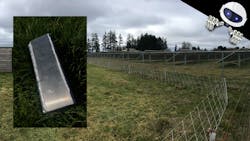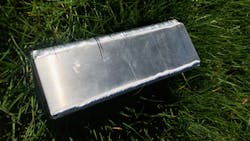Pioneering Organic Welding Certificate Program Debuts at Oregon College
This article is part of our April 1st series.
You can also download the PDF eBook of this series.
What you'll learn:
- What is organic welding?
- How to obtain a certificate as an organic welder.
Portland Commune/IT College today announced that its industrial welding program would begin offering students at its Stone River campus the opportunity to qualify as "certified organic welders" beginning in the fall 2023 semester. In doing so, the college will become one of the first institutions to introduce students to the sustainable technologies and practices that appear to be gaining acceptance within the parts of the industry.
Started in 1972 as a commune by Hippies looking to escape the California scene, the Great Legume Famine of Vegetarians in 1973 forced the somewhat responsible members of the commune to reluctantly seek employment. The most lucrative use of their commune-constructing/maintenance experience would be in the trades, including automotive repair, welding, electronics and machine shop operations, to keep their chicks and barefoot kids from starving to death.
After six or seven years of stacking Benjamins, the collective decided to bring their breadwinners home and use the money to open an Industrial Technology college on the commune to teach others how to ply these trades. Their perseverance paid off and in 1989, Portland Commune/IT College became accredited by, among others, the American Welders’ Society (AWS), Automotive Service Exceptionals (ASE), and the International Society of Certifiable Electronic Technicians (ISCET). After over three decades of operation as an academic institution, the school proudly boasts it has graduated over 5,000 students in Industrial Tech.
We caught up with Alaska Scot, Welding Department Chair, to find out more about their new organic welding certificate program.
How did the school become aware of the need for organic welder certification?
I was at Hole Foods, which is a local grocery store that also spun out of our commune, picking up some kale and lentils for one of my partners, Willow, and noticed that none of the kitchen gadgets and pots and pans had any welds in them. Not one.
The wheels in my head started turning when the light came on that for such items to sell in this kind of store, they would have to be certified organic. A visit to a similar-sounding national chain revealed the same results—not a single weld was to be found in any product sold in the store because there’s no present way to certify a weld as being organic.
How can a piece of aluminum or stainless steel be organic? It’s not like it might be pesticide-contaminated!
There’s a lot more to that scene, man. It’s all about sustainability and how we treat Mother Earth. It’s about how kind we are to Gaia in extracting minerals, how we process materials, and what kind of carbon footprint we leave in our wake. “Organic” is leaving our Earth in better shape than when you dropped into it by natural birthing methods.
So, what can be done to certify a welder and their welds are “certified organic”?
Well, the first thing we did was to get the school and shops fully sustainable. Back in 2012, the school partnered with the State of Oregon to install a solar array that generated 537,412 kWh in 2021. Though this has been quoted in the press as a carbon offset, “number of miles driven in your ICE car” kind of thing, with our backgrounds in electronics we wanted to take the array direct to our highest power-consuming education programs vs. running through stages of lossy power conversions, only to sell credits back to encourage carbon polluters to buy their way out of cleaning up their act, man.
We would presume that would be the welding program?
Correct. We realized we could modify the welding machines, in particular the “clean”-welding TIG welding power supplies, to directly power the dc link stage of the welders’ inverters from the solar array. After messing around with that one for a few months, one of our electronics-tech students asked why we were feeding 408 V dc into the inverters’ dc link when each solar module produced 300 W of power at about the 30 V we use for TIG welding.
So, we built ourselves some customized switchgear where the school could either grid-tie the solar array for PGE’s feed-in tariff and for carbon credits, or we could take the solar array off-grid and switch a quantized amount of maximum current, in the 10-A steps of each solar module at the nominal 30 V or so that we use for our TIG welding. With 16 solar modules arranged in parallel, we can weld at up to 160 A on a sunny day, which is good enough to weld up to 12-gage aluminum.
But TIG welding requires fine current control, not discrete steps like a buzzbox for stick welding…
True that. We got clever with the amperage control pedal used in TIG welding, in that it is now servoed to the solar incidence tilt of the solar panel—move it away from direct sunlight with your welding-set pedal and reduce the welding current. Using an air-cooled TIG torch means we can produce welds directly from the solar panel, with zero efficiency losses and discourage too much daily use.
We deduct 5 points from the final grade if we see TIG torch burns on the students’ hands. We try to teach responsible welding work ethics, and we believe teaching this kind of diligence and productivity would be fully endorsed by the welders’ unions.
Your current-control scheme seems a bit unwieldy, given the mass of that solar array.
Controlling weld current in this fashion definitely means a more refined TIG welding technique, since current response to pedal position is now affected by the inertia of the array, as you’ve observed. We plan to improve the system’s dynamic response to current control by using aluminum for the array’s metal framework, replacing heavy steel, and by thinning the solar cells to two microns using Rayton’s wafer-thinning particle-beam-accelerator technology.
They had a good thing thinning solar cells, then likely got derailed by a know-it-all VC. Imagine skinning cars with two-micron thick solar cells—they’d conform to almost any body contour and might be thin enough to be transparent and used on windshields. But, no, they’re off doing unimaginative poop.
Learning on green-tech welding machines is certainly a huge step. What else makes the students and school worthy of an organic welding accreditation and certification?
We’re releasing the solar TIG machine design as OpenSource on GitHub. To meet their final-term capstone project deliverable and graduate with the Organic Welder Certification, each student must build both the solar array and TIG machine and will have demonstrated the welds found in any TIG welding certification program. We’ve run a pilot program with student volunteers this semester, which has just wound down, and I’m happy to share a photo with you of a sustainably created weldment off the 30-V, variable incidence, solar setup.
Apart from proliferating the green TIG welding supply design, what else is taught in the program?
We have rigorous courses that teach sourcing, where our welders are taught to refuse to use aluminum from mines that have not committed to using fully electric mining equipment by 2030. In that supply chain, aluminum smelters also must source the vast amounts of electricity they consume from either wind, solar, hydro, or tidal sources.
We teach our students about how dirty commercially viable production of hydrogen is, and how biofuels are a really bad idea in that they compete for our food and fresh water supply. We also encourage using recycled and scrap materials, even minimizing scrap waste by incorporating it into practice sessions and in graded welds—10% of the grade is affected by demonstrating welding assignments on scrap aluminum.
What else is the school doing?
We’re requiring 60% of our staff to use electric vehicles or bicycles by 2025, with 100% by 2030. We’re already at 100%
Can you talk about what the startups are doing?
I really cannot in order to protect our next-round funding and exit. But suffice it to say that my laments while I was out lentil shopping will be fully addressed. For us welders, there’s no finer jewelry than a perfect stack of dimes weld. Now imagine that in your handmade, organic pots and pans.
You have other programs in the Industrial Technology college. Can you talk about green tech in those programs?
I’m primarily the go-to welding guy, obviously, but Portland Commune/IT College’s automotive guys are putting together the course syllabus for repurposing salvage and used electric-car batteries. They’re offering a progression of coursework where the graduating student ends up with the car they converted in the coursework when they graduate. We have donations from several OEMs of packs that have QC blemishes on the packs, but they’re fully functional.
The electrical guys are looking at producing sustainably sourced free-range semiconductors and other green technologies, with some encouraging results from their research group on using bananas as ion-implanter beam sources for semiconductor processing. This being April 1, you don’t know what to believe.
Read more articles like this in our April 1st series in the Humor section of our Series Library.


